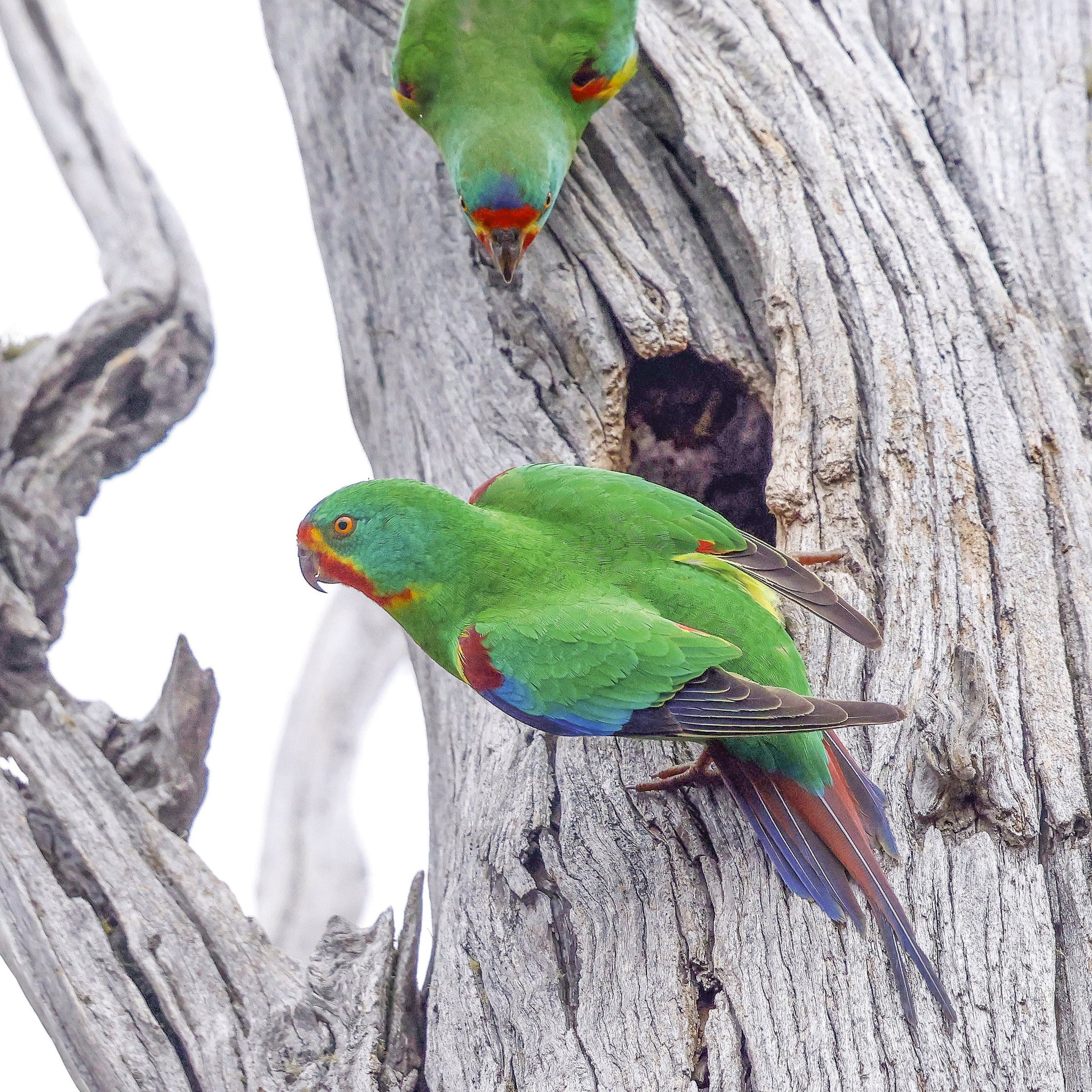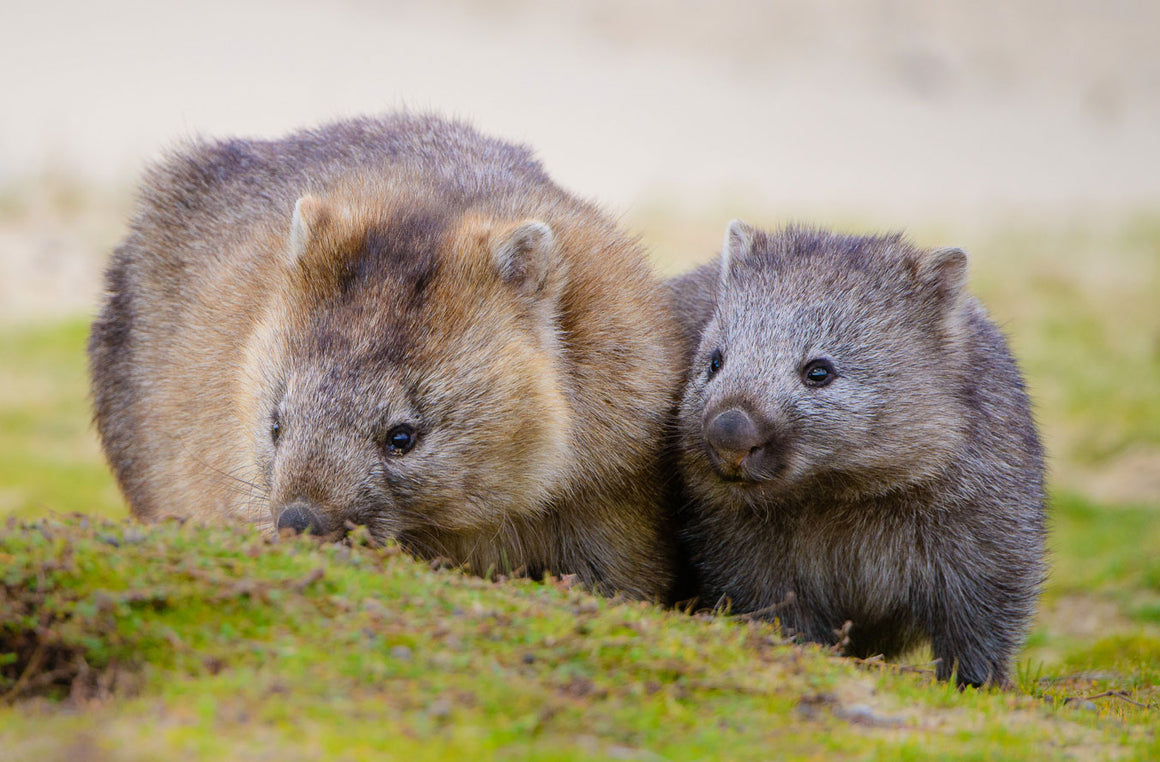Rob Blakers - Swift Parrot Pair & Nest, Eastern Tiers
$200.00
Swift Parrot Pair & Nest, Eastern Tiers
Logging Area SH050B
Rob Blakers
photograph on Canson Platine Rag
40 x 40cm
All of the Swift Parrots in this exhibition were photographed within or immediately adjacent to areas proposed for logging in 2023 or 2024.
The aptly named Swift Parrot (Lathamus discolor) is a small, streamlined parrot, one of just three migratory parrots in the world, along with the Orange-bellied Parrot and the Blue-winged Parrot. Of the parrot species it has the longest known migration.
Swift Parrots breed only in Tasmania, generally in the southeast and east, but also in the northwest. They utilise different parts of their breeding-range in different years, depending on eucalypt flowering conditions and nesting sites. ‘Nesting habitat’ for Swift Parrots is mature eucalypt forest with hollow-bearing trees, located close to ‘foraging habitat’, primarily flowering Tasmanian blue gum (Eucalyptus globulus), black gum (Eucalyptus ovata) and Brooker’s gum (Eucalyptus brookeriana). Swift Parrots migrate across Bass Strait in March and April to overwinter in south-eastern Australia, roaming vast distances in search of food - as far north as south-eastern Queensland and as far west as Adelaide, matching their dispersal to the distribution of flowering trees in a given year, before returning to Tasmania in August/September to breed.
The Swift Parrot was once a common bird - in 1848 Gould remarked on the great abundance of small flocks around Hobart, and even as recently as the 1960s, flocks of 2000 were recorded foraging in the same place for months at a time. The recent decline has been rapid. An estimate in 2011 suggested that there were 2000 birds remaining, but a 2021 analysis found it likely that there were just 750 birds left in the wild.
The Swift Parrot is listed as Critically Endangered under the Environment Protection and Biodiversity Conservation (EPBC) Act 1999 and by the IUCN Red List of Threatened Species. In 2015 the International Union for Conservation of Nature (IUCN) listed the Swift Parrot as Critically Endangered and recommended that all public lands that support Swift Parrots be placed under secure, permanent conservation management.
The logging industry in Tasmania is exempt from the national environment laws that would otherwise protect essential breeding and foraging habitat of the Swift Parrot. Thousands of hectares of such habitat have been logged in recent decades and the ongoing logging of native forests is the key factor driving Swift Parrots towards extinction. Logging, paused for the summer in forests where verified Swift Parrot observations are made, routinely resumes once the parrots have vacated those forests for their overwintering range in southeast Australia. Essential breeding and foraging habitat of old, hollow-bearing trees is being systematically converted to tree farms of perennially young trees, inimical to nesting.
The Swift Parrot is being logged to extinction.
In 2020, Swift Parrot expert Dr Matthew Webb stated that: “The continuation of logging of the Swift parrot‘s habitat (feeding and nesting) will lock the species into extinction. Without its habitat, all other threats the species faces become irrelevant” For the Swift Parrot to have a future, decisive action from government, state and federal, is required. We no longer have the option - or time - for prevarication and business-as-usual adaptive management.
Extinction happens incrementally - the Swift Parrot population is now so depleted that any further loss of habitat pushes the species closer to the edge. The Swift Parrot is our environmental canary - its fate, and the fate of a cascade of other wildlife, depends on the maintenance of old trees and native forests.
We cannot let the insatiable demands of our time consume this stunningly beautiful bird. Protection of all Swift Parrot habitat nationally is a critically urgent response to the biodiversity and climate crises - and is the slender life-line to the future for this extraordinary and beautiful bird.
Rob Blakers has photographed in the wild places of Tasmania for over 40 years. His interests lie in landscape, environmental conservation and the evolution of photographic methods and values in the age of digital technology.
Please Note:
images are made to order and require 10-15 days for printing & framing from order/purchase date.
Images purchased directly from the gallery wall can be collected directly from Wild Island at the end of the exhibition. Alternatively we can arrange for shipping via courier within Australia for an additional freightage cost.
Please contact the gallery directly for a shipping estimate.


